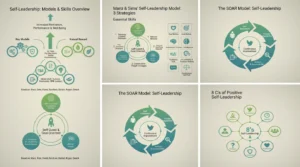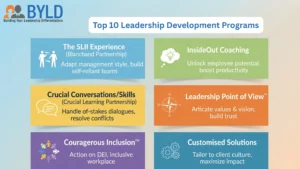
What is Leadership Training, and Why is it Important?
- Our Subject Matter Experts
- September 2, 2025
- 3:25 pm
- No Comments

In today’s dynamic and competitive business landscape, leadership training has become a necessity rather than a choice. Organizations across industries need leaders who can adapt, inspire, and drive results. Whether you’re a mid-level manager aspiring to take on bigger roles or a company aiming to strengthen your leadership pipeline, a well-designed leadership program provides the tools and mindset required to succeed.
What is Leadership Training?
Leadership training is a structured approach to developing individuals’ skills to lead people, manage teams, and make effective decisions. It goes beyond managing day-to-day operations. Leadership training empowers leaders to inspire, innovate, and create long-term impact.
Through workshops, coaching, and experiential learning, participants learn critical skills like communication, emotional intelligence, strategic thinking, and conflict resolution.
Why Leadership Training Matters for Organizations
Companies that invest in leadership development training see higher employee engagement, productivity, and retention. A well-trained leader fosters trust, reduces workplace conflicts, and ensures organizational goals are met.
Some key benefits of leadership training include:
- Improved decision-making: Leaders learn to analyze situations objectively.
- Stronger team dynamics: Training enhances communication and collaboration.
- Better change management: Leaders can handle transitions with confidence.
Long-term success: Leadership training helps build future-ready leaders.
Core Skills Taught in Leadership Training Programs
A leadership program is designed to build a diverse set of competencies. Common focus areas include:
1. Communication and Emotional Intelligence
Leaders need to inspire teams, resolve conflicts, and build trust. Leadership training emphasizes active listening, empathy, and persuasion.
2. Strategic Thinking
Great leaders think beyond short-term wins. Leadership development training builds skills to forecast industry trends and align organizational goals accordingly.
3. Decision-Making and Problem-Solving
Leadership is about making tough decisions. Training equips leaders with frameworks to analyze risks and choose effective solutions.
4. People and Performance Management
A core part of organizational leadership is motivating teams, setting KPIs, and giving constructive feedback.
5. Adaptability and Innovation
Modern leaders need to embrace digital transformation and encourage creative solutions. Leadership training builds agility in fast-changing environments.
Types of Leadership Training Programs
Different organizations need different approaches to leadership. Here are the main types of leadership programs:
1. Executive Leadership Training
Focused on senior managers and executives, this program emphasizes strategic decision-making, organizational leadership, and visionary thinking.
2. Emerging Leaders Program
Designed for high-potential employees preparing for leadership roles. It covers foundational skills such as communication, team management, and accountability.
3. Team Leadership Development Training
This training helps managers and supervisors improve collaboration, conflict resolution, and performance management within teams.
4. Organizational Leadership Training
Aimed at aligning leadership styles with company culture and long-term goals. It ensures leaders across all levels maintain consistency in vision and execution.
5. Specialized Leadership Workshops
Short-term workshops on niche topics such as crisis management, diversity and inclusion, or digital transformation leadership.
Leadership Development Training vs. Leadership Training
While the terms are often used interchangeably, there is a subtle difference:
- Leadership Training → Short-term, skill-based sessions focusing on communication, management, or decision-making.
- Leadership Development Training → A long-term, structured approach aimed at building future-ready leaders through coaching, mentoring, and continuous learning.
Both play a crucial role in enhancing organizational leadership.
The Role of Organizational Leadership
Organizational leadership is about guiding an entire organization toward long-term goals while balancing people, processes, and culture. Unlike traditional management, it emphasizes vision, inspiration, and transformational change.
Leadership training helps individuals understand how their actions align with company strategy, making them more effective organizational leaders.
How to Choose the Best Leadership Program
When selecting a leadership training program, organizations should consider:
- Relevance to Business Needs – Training should match organizational goals.
- Practical Learning Methods – Look for simulations, role-plays, and real-world problem-solving.
- Customization Options – A one-size-fits-all approach rarely works. Programs should be tailored to industries and company culture.
- Expert Trainers – Programs led by experienced leadership coaches create lasting impact.
Long-Term Support – Leadership development should be continuous, not a one-time event.
Leadership Training for Different Levels of Leaders
1. Emerging Leaders
Early-career professionals who show potential can benefit from leadership development training to prepare for managerial roles.
2. Mid-Level Managers
Managers balancing execution and strategy gain advanced leadership skills to manage larger teams.
3. Senior Executives
Executives refine organizational leadership to lead at the highest level, shaping culture and long-term strategy.
Future Trends in Leadership Training
The landscape of leadership is evolving. Some emerging trends include:
- Digital leadership training programs using AI and virtual simulations.
- Personalized leadership development training powered by data analytics.
- Focus on diversity and inclusion to build equitable workplaces.
Sustainability-driven organizational leadership that integrates social responsibility.
Final Thoughts
In today’s dynamic business environment, leadership training is one of the best investments for personal and organizational growth. Whether through a leadership program, leadership development training, or focusing on organizational leadership, companies can build resilient, innovative, and future-ready leaders.
Strong leadership ensures better decision-making, improved employee engagement, and long-term organizational success. For any business aiming to thrive, prioritizing leadership training is not optional, it’s a necessity.
Lorem ipsum dolor sit amet, consectetur adipisicing elit. Optio, neque qui velit. Magni dolorum quidem ipsam eligendi, totam, facilis laudantium cum accusamus ullam voluptatibus commodi numquam, error, est. Ea, consequatur.
Lorem ipsum dolor sit amet, consectetur adipisicing elit. Optio, neque qui velit. Magni dolorum quidem ipsam eligendi, totam, facilis laudantium cum accusamus ullam voluptatibus commodi numquam, error, est. Ea, consequatur.
Lorem ipsum dolor sit amet, consectetur adipisicing elit. Optio, neque qui velit. Magni dolorum quidem ipsam eligendi, totam, facilis laudantium cum accusamus ullam voluptatibus commodi numquam, error, est. Ea, consequatur.






